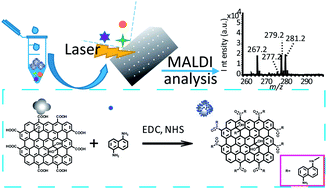1,5-Diaminonaphthalene functionalized carbon nanodots as a novel matrix for the analysis of small molecules by matrix-assisted laser desorption/ionization mass spectrometry†
Abstract
1,5-Diaminonaphthalene functionalized carbon nanodots (DAN-CDs) were explored as a novel matrix for direct detection of small molecules by matrix-assisted laser desorption/ionization mass spectrometry (MALDI-MS) in negative ion mode. By using DAN-CDs as the matrix, we could detect not only biological small molecules such as fatty acids (FAs), amino acids, peptide Gly–Gly and dopamine, but also anticancer drug erlotinib. By comparison with the performance of CDs, DAN, and their binary matrix, DAN-CDs were favored because of their lower matrix background interference and good detection sensitivity. In addition, the DAN-CDs matrix displayed good salt tolerance and was further applied for plasma detection and qualitative detection of endogenous FAs in a plasma sample. Furthermore, the covalent amide bonds in the DAN-CDs matrix reduced signal interference from the matrix. These results demonstrated that DAN-CDs are a novel negative ion mode matrix for the analysis of small molecules in bio-samples by MALDI-MS.



 Please wait while we load your content...
Please wait while we load your content...